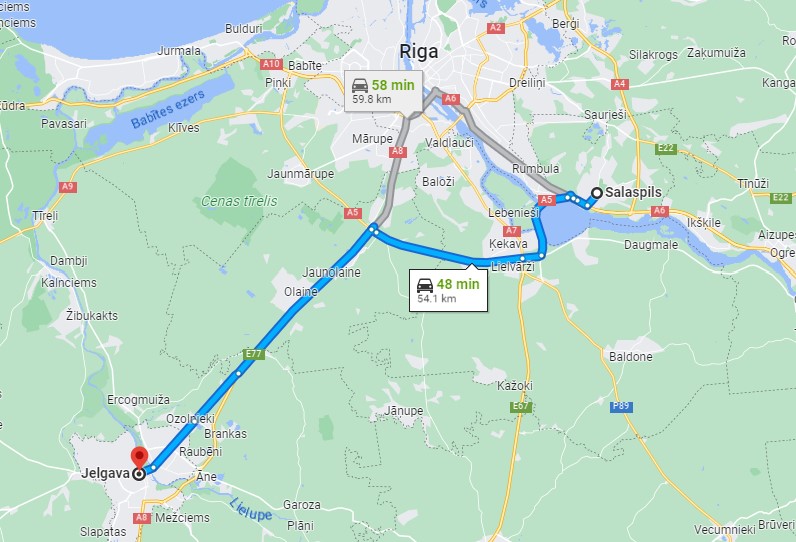Were our Abramowitz ancestors from Salaspils or Mitau (Jalgava) or from somewhere else?
Our Abramowitz Great-grandparents
Gussie’s mother was Yetta/Jetta Shmarkovich (aka Etel Smetkovitz) and her father was Hirsch (Harry) Lev/Leib Ha Levy.
Hirsch and Etel had 10 children: Max, Sarah, Gussie, Samuel, Abe, Chana Mera (Anne Marie), Leiser, Salman, and 2 more boys whose names we do not know. To learn a little bit Hirsch and Etel, click on their names under the Abramowitz menu. To learn a little bit about each one of their children, click on Gussie’s Siblings under the Abramowitz menu.
From family stories, we know that Gussie grew up in Courland, outside of Riga. From various documents, we know the family lived in Salapils and Mitau.
Salaspils
Sadly, based on the YadVasheem database listing for Leiser Abramowitsch, son of Hirsch, we learn where Hirsch and Yetta Abramowitz lived with their family. Were all of the children born here, or did they live somewhere else before Leiser was born? It appears they lived, at least for a time, in Salaspils, Rigas, Vidzeme, Latvia. (1) (2)

Being one of the oldest settlements, Vidzeme is now one of the historical and cultural regions of Latvia. It means “the Middle Land” and it is situated in north-central Latvia north of the Daugava River. In German, it is known as Livland and in Latin, Livonia. The Riga-Daugavpils railway opened in 1861 which led to growth in the area. There were about 9,000 Jews in Livonia by the middle of the 19th century. Once the railway opened, many of these places because surburbs of Riga and were considered “outside” of Riga. (3)
Russia conquered Livonia, along with Riga, from Sweden in 1721. Beings outside the Pale of Settlement, Jews who could prove that they had lived there legally before the takeover, were allowed to stay in Livonia. Even though they were allowed to stay, life for the Jews was always difficult and they were never considered “Latvian”.
In 1905, life once again became hard for the Jews as they were blamed for inciting riots during the revolution of 1905. Many Latvians (and Jews) were executed, others were deported to Siberia, and still others left the country. This ruling directly affected my Abramowitz family as you will see from reading the page on Chana Mera.
Mitau
Grandma Gussie always told me she was from Courland. Courland, it turns out, was a Gubernia and was divided into 10 districts: Bauske, Friedrichstadt, Goldingen, Grobin, Hasenpoth, Illuxt, Mitau, Talson, Tuckum, and Windau.
Mitau (today known as Jelgava) was the capital of the Courland Gubernia. In 1882, the population of all of Courland was about 642,570 of which only 8% was Jewish. Jewish life was never easy. As. a matter of fact, in the late 1700s those who were burghers and merchants had to pay double the tax of their Christain neighbors. This was abolished in 1807 after Tsar Alexander I came to power. (4)
Howerever, in 1829, all the rights granted to the Jews in 1799 were rescinded and the following resolutions were passed:
(1) That there be recognized as inhabitants of Courland only such Jews as at the last census had been entered in the registry lists of the Courland Chamber of Justice. (2) That each family of such Jews receive a certificate of its right to settle in Courland. (3) That Jews from other governments be prohibited from settling in Courland. (4) That Jews who removed from Courland lose the right of returning thither. (5) That the marriage of a Courland Jewess to a Jew from another government confer upon such Jew no right to live in Courland. (6) That a Courland Jewess marrying a Jew from another government and removing with him thither lose the right of residence in Courland. (7) That Jews not holding the above-mentioned certificates leave the country; and that those who do not present their certificates in time or were guilty of violating any of the foregoing regulations, be sent to settle in Siberia
(5)
The Jews of Courland believed in enlightment, which began in Germany. They were a cultured people. The first Jewish school based on modern principles was started in Mitau in 1824. Even the poorest among the Jewish population sent their children to school, whether it was a Christain school or a Jewish religious school. (6)
In 1881, after Alexander II became the Tsar, “Russification” began. The Russian administration took over the schools and the judicial system. They started to enforce the use of the Russian language in the entire region for all religions. (7) Russification was defined as
. . . cultural assimilation definable as “a process culminating in the disappearance of a given group as a recognizably distinct element within a larger society”
(8)
The Russian Revolution of 1905, which began on January 22, 1905, was due to political and social unrest. It was directed against the Tsar, the nobility and the ruling class. Thousands and thousands were killed, imprisoned or deported. (9)
How did these troubles affect our Abramowitz family and their decision to leave or stay? We will never know for sure why some of the family stayed while others immigrated or got deported. However, we can make some guesses which you will learn about as you read about each family member.

Above is a map showing Riga, Salaspils, and Jelgava (Mitau), three of the places in our Abramowitz story. (10)
Sources
- (1) Leiser Abramowitz, Yad VaShem Page of Testimony
- (2) Salaspils HIstory
- (3) Vidzeme History
- (4) (5) (6) Courland: by Herman Rosenthal, from the Jewish Encyclopedia
- (7) The Courland Region
- (8) (9) Russian Revolution of 1905
- (10) Map showing Riga, Salaspils, and Jelgava (Mitau)
Note: The Abramowitz section was updated in April of 2023 with new information we learned in our recent research. It might change again as we learn more.
